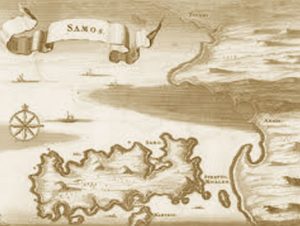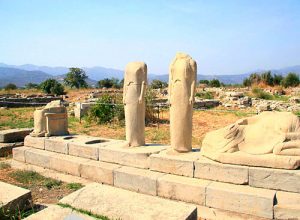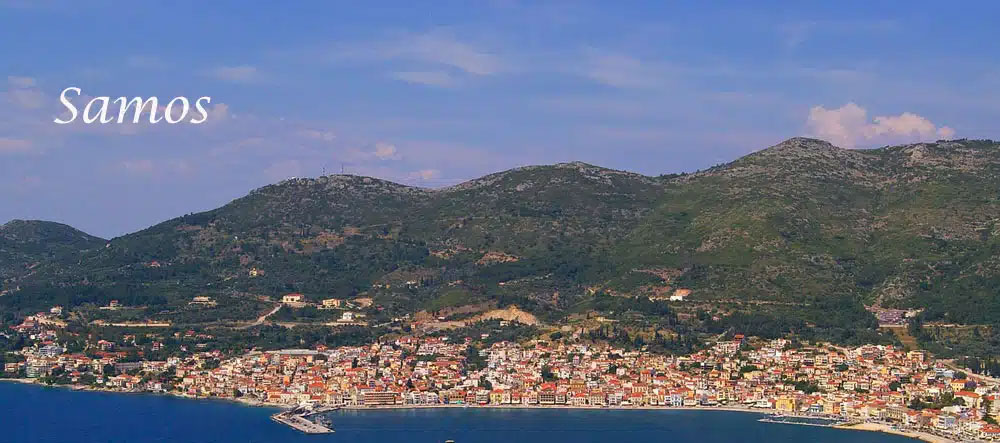History of Samos island

During the time of the rule of the island by Polycrates, Samos became one of the largest centers of the Ionian Civilization, having to display great works and important monuments, among which are the Eupalineo trench, the temple of Hera, but also theaters, palaces and much more.
During the times of Polycrates, the famous library was also founded, which included all the important works of the time, with the result that the courtyard of the library turned into a particularly remarkable intellectual center and hosted the greatest intellectuals of the time.
But Polycrates also paid special attention to military matters and so soon Samos had a very powerful army and its fleet with the famous and very fast Samenes dominated the Aegean until the time when Athens appeared with the newest and most sophisticated Athenian triremes. As Herodotus typically wrote, there were three important cities that dominated the Aegean and the Mediterranean Sea until his days.
Knossos of King Minos (15th century BC), Samos of the tyrant Polycrates (6th century BC) and the democratic Athens of Pericles (5th century BC). As was typically said, Samos was the first city between the Greeks and the barbarians, and Polycrates was the first Greek who tried to unite the Greeks to face the threat of the all-powerful Persians.

Other important names were the great painter Agatharchos, the famous architect Theodoros, the famous Aesop with his well-known fables, the daring seafarer Coleus who, as is said, was the first to venture and successfully travel across the Atlantic Ocean and finally the pride of antiquity, the great philosopher Damo, daughter of Pythagoras.
In the following years, Samos had declined and simply followed the fate of the rest of Greece, falling into the hands of the Macedonians, the Romans and the Byzantines, at which point it was tested, like the entire Aegean, by pirate raids. After the fall and destruction of Constantinople by the Crusaders, the island passed to the Venetians, it was reoccupied for a while by the Byzantines and finally in 1346 it came under the rule of the Genoese.
Byzantine period
The written testimonies about Byzantine Samos are particularly limited. When Christianity succeeded polytheism on the island remains unknown. The fact that it is very close to Ephesus probably contributed to its early Christianization. A typical example is the basilica built in the 5th century in the area of Tigani.
Early Christian basilicas can be found in various parts of the island, in urban centers and in the countryside. The majority of these basilicas show during the second half of the 6th century a second building phase, while there are remains of additions, some of which were intended for the production of oil and wine. In the 6th century, Samos prospered and traded its goods by sea to distant regions. Among others, the German School’s excavations in the Pythagorean basilica provide evidence for early Byzantine Samos.
Samos has been a diocese since the 5th century with an auxiliary bishop in Rhodes and retained this position until the 12th century.
At the end of the early Byzantine period, many areas along its coasts were abandoned, and the inhabitants moved inland. At that time, Kastrovouni was inhabited, which is located between Karlovasos and Vourliotes. The construction of the castle of Lazarus in Vourliotes is also attributed to the 7th century.
During the Middle Byzantine period, Samos was at the heart of the medieval Byzantine Empire. Its strategic position led the central authority to fortify the island and create the naval theme of Samos. The establishment of the subject is dated to the 8th-9th century, while the references to the generals of the subject continue until the 11th-12th century.
Already from the 4th century the Aegean area was the center of the Mediterranean because of Constantinople. Even after the crisis of the 7th century, its economic network remained complex while there was direct communication between the islands and the mainland, which was not the case for the rest of the Mediterranean.
During the time of the Crusaders the island passed to the Venetians, then returned to the Byzantines and finally ended up in 1346 to the Genoese Samos was probably one of the first victims of the Arab attacks of the 7th century, an era known to scholars for the naval expansion of the Arab caliphate of Damascus.
The date of this first attack was based on archaeological evidence, which coincides with a reference to an Arab source. According to Elisabeth Malamut, the attack on the island took place in 665. This raid is a stop in a series of captures of key points on the road to Constantinople, which was completed by Moabius I, governor of Damascus and Syria and later the first caliph of the Umayyads.
From the year 648 to the year 675 AD Cyprus, Arad on the Syrian coast, the coast of Asia Minor, Rhodes, Kos, Crete, Samos, Kyzikos, Smyrna, and the coast of Lycia are occupied in the following order, while a new raid is made on Rhodes and, finally, in Crete. However, Theophanes does not mention Samos anywhere in his work in relation to the operations of 665, in contrast to the chronicle of Al-Baladhuri, the Persian chronicler of the early years of the Arab state and their spread.
This report by Al-Baladhuri is very important, as it is consistent with the finds from the Eupalinian Trench, which testify that the trench served as a shelter during the raid of 665/6 AD. However, the connection of the first Muslim raids of the second half of the 7th century with monuments dating from this period, such as the castle of Lazarus, as well as various monasteries, remains problematic.
Due to the many pirate raids, the inhabitants started to leave the island until in 1476 the last ones left it together with the Genoese. Samos stayed almost deserted, with few inhabitants who lived in the mountains
Turkish rule
But wars and successive raids had destroyed Samos and it was slowly deserted and abandoned by all the inhabitants and by the Genoese conquerors themselves. Since then, around 1476 and for almost a century Samos was inhabited by a few shepherds in the mountains. In 1549, the Ottoman fleet passed through Samos under the leadership of Admiral Kilic Ali Pasha, a former French prisoner who rose to high military positions, who was fascinated by the wonderful environment of the desert island and asked the Sultan to give it to him.
So the Pasha became the master of Samos and tried to attract new residents to the desert island by offering important and unprecedented privileges to the new residents that the only thing they had to fulfill was to be Greek and Christian Orthodox.
Then many new inhabitants came from all the neighboring islands, Asia Minor. The following years also from the Peloponnese and Crete. Then the first villages were created, roughly the ones we know today. After the death of the Turkish admiral who loved the island very much, a Turkish commander was installed, but again with the privileges that the Samians managed to maintain, they were in an advantageous position in relation to the situation of the other people of the region.
Samos during the centuries after the fall of the Byzantine Empire lost its population and for a long period remained relatively deserted. Settlements were preserved in the mountainous areas of Kerkis and Ambelos. In the 16th century, most of today’s settlements were created. In the 18th century, a network of villages spread over the entire length of the island. The capital was Chora and the main port was Tigani (today’s Pythagorion). Gradually, Vathi and Karlovasi began to develop, which a century later became urban centers.
The Turkish fleet passed to Samos in 1549 with Kilits Ali Pasha as admiral. The Pasha, admiring the beauties of the island, wanted to repopulate the island. The “high gate” gave unprecedented privileges to the new residents, who had to be Greek and Christian Orthodox.
Thus, Samos began to be filled with new inhabitants who came from the surrounding islands, Asia Minor and a little later from the Peloponnese and Crete, creating the first villages.
Recent History
In 1821 Samos also rebelled against the Turks and despite the repeated attempts of the Turkish fleet to conquer the island, it did not succeed. After the establishment of the Greek state in 1827, the then powers (England, France and Russia) did not include Samos in it, although it was free.
In 1834 the Samians reacted and the great powers gave it a form of autonomy, Hegemony, and placed it under their protection, with the obligation to pay tribute to Turkey. This regime was maintained until 1912 when it was united with Greece. During this period, Samos experienced a very large economic boom .
Greek revolution
Samos declared the revolution on April 20, 1821 with the commander Constantis Lachanas. The administration of the revolution on the island was taken over by Lykourgos Logothetis. Samos did not join the new Kingdom of Greece. It became an independent principality under the name Hegemony of Samos. The ruler was appointed by the Sultan, had the title of prince, was an Orthodox Christian and a senior member of the Ottoman Empire. The capital of the principality was initially Chora and then the capital was moved to Vathi.
Unification with Greece
Samos was incorporated into Greece in 1912. During World War II the island was initially under Italian occupation. In November 1943 the Germans proceeded with bombing. The island passed under German administration until the liberation of Greece.
